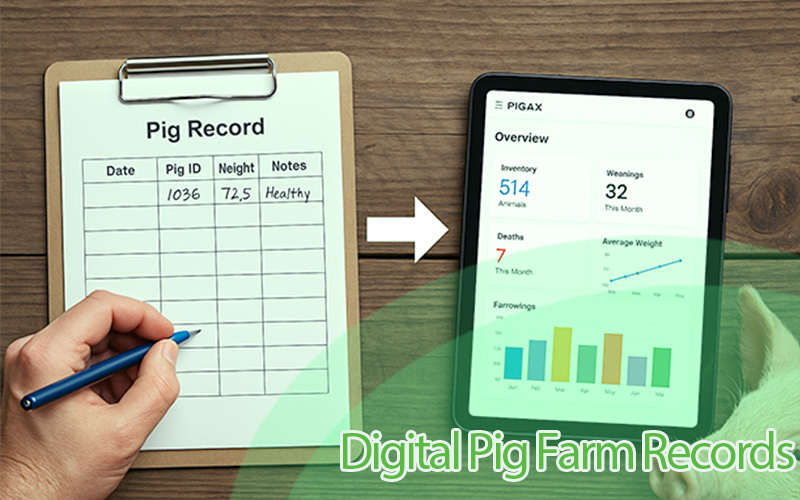Track the growth rate of your Pigs with these 3 metrics and boost feed efficiency
Pig growth is one of the major targets of pig farming. That is why you find yourself staring at your pigs for a long time trying to figure out if they are growing or not, this is normal but it is not satisfying because the result is always inconclusive. To know truly if your pigs are growing, you need measurable facts and figures. Yes, you need to weigh them. But to know the rate at which they grow you need to do more. This will require some calculations and is more convenient when using a Pig management App. Let us now go through 3 metrics you must know in order to figure out the rate at which your pigs are growing.
AVERAGE DAILY GAIN (ADG)
In pig farming, ADG stands for average daily gain, which is a measure of the average amount of weight that a pig gains per day. Average daily gain is an important indicator of the growth and productivity of a pig herd, and it is often used to assess the effectiveness of different management practices and to make comparisons between different herds. A high average daily gain indicates that the pigs are growing well and that management practices are effective, while a low average daily gain may indicate that there are problems that need to be addressed.
To calculate average daily gain, the weight of a pig is measured at regular intervals (such as weekly or monthly) and the difference in weight between each measurement is divided by the number of days between measurements. This provides an average daily gain for that period of time.
Average daily gain is influenced by a variety of factors which includes
- Genetics: Pigs with good genetics will tend to have a higher average daily gain than those with poor genetics.
- Feed and nutrition: Providing a balanced and nutritious diet is essential for maintaining good growth and health in pigs. Poor quality feed, inadequate intake, or imbalanced nutrient ratios can all lead to reduced average daily gain.
- Health and disease management: Pigs that are in good health are more likely to grow well, while those that are sick or suffering from infections or other health issues may have a lower average daily gain.
- Housing and facilities: The design and management of pig housing and facilities can have a significant impact on average daily gain. For example, overcrowding or poor ventilation can lead to reduced growth and poorer overall health.
- Environmental factors: Environmental factors such as temperature, humidity, and lighting can also affect the average daily gain. For example, pigs may grow more slowly in very hot or cold conditions.
- Age: Average daily gain tends to be highest in young pigs and decreases as they get older.
FEED CONVERSION RATE (FCR)
In pig farming, FCR stands for Feed Conversion Ratio, which is a measure of the efficiency with which a pig converts feed into weight gain. FCR is calculated by dividing the total amount of feed that a pig consumes by the amount of weight that it gains over a specific period of time. For example, if a pig consumes 10 kilograms of feed and gains 5 kilograms of weight over a period of two weeks, its FCR would be 2 (10 kilograms of feed divided by 5 kilograms of weight gain). A lower FCR indicates that the pig is more efficient at converting feed into weight gain, while a higher FCR indicates that the pig is less efficient.
FCR is an important indicator of the efficiency and productivity of a pig herd, and it is often used to compare the performance of different herds or to assess the impact of different management practices on feed efficiency. Factors that can affect FCR include genetics, feed and nutrition, health and disease management, housing and facilities, and environmental factors.
To improve FCR in pig farming, it is important to focus on factors that can affect feed efficiencies, such as providing a balanced and nutritious diet, managing health and disease effectively, and optimizing housing and facilities. It is also important to monitor FCR regularly and to make any necessary adjustments to management practices in order to maintain good feed efficiency and productivity.
AVERAGE DAILY FEED INTAKE
AFI stands for average daily feed intake, which is a measure of the amount of feed that a pig consumes on a daily basis. AFI is typically expressed in kilograms per day or per pig. To calculate AFI, the total amount of feed that a pig consumes is weighed over a specific period of time (such as a week or a month) and then divided by the number of days in that period. This provides the average daily feed intake for that period.
AFI is an important indicator of the feeding behavior and nutritional status of a pig, and it is often used to assess the impact of different management practices on feed intake and to make comparisons between different herds. Factors that can affect AFI include genetics, feed and nutrition, health and disease management, housing and facilities, and environmental factors.
To improve AFI in pig farming, it is important to focus on factors that can affect feed intakes, such as providing a balanced and nutritious diet, managing health and disease effectively, and optimizing housing and facilities. It is also important to monitor AFI regularly and to make any necessary adjustments to management practices in order to maintain good feed intake and productivity.




